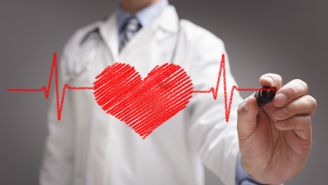Updated on May 23, 2024.
You may not realize it, but electrical signals are running through your body all the time. In your heart, for example, natural electrical signals cause your heart to beat.
How your heartbeat works
In an ordinary heart, an electrical signal starts at the top of the heart and spreads to the rest of the heart. This prompts the heart muscle to contract, which squeezes blood from the two upper chambers (the atria) into the two lower ones (the ventricles).
Then, as the signal travels down your heart, it prompts the ventricles to contract, pushing blood to the rest of your body. Once they are empty, the ventricles relax and fill with blood again until another signal starts the process again. This constant contracting and relaxing of your heart is your heartbeat. It’s also known as your heart rhythm.
When your heartbeat goes awry
But what happens if the signal doesn’t travel through the heart in a steady, organized way?
This is what happens if you have a heart rhythm problem, also known as an arrhythmia.
There are several types of arrhythmia. The most common type is when you have premature (extra) beat. This typically feels like a skipped beat or a fluttering in the chest, but it doesn’t usually pose a health risk.
Sometimes, though, the signals can cause potentially serious problems. This is the case in an arrhythmia called atrial fibrillation (or AFib). If left unchecked, AFib can lead to a stroke and even heart failure. Knowing more about the heart’s electrical system will help you understand the causes, symptoms, and risks of AFib, and how your healthcare provider (HCP) might treat it.
Understanding the heart’s electrical system
“The heart’s electrical system is a very organized, synchronous, very smart system,” says Guru Mohanty, MD, a cardiac electrophysiologist with Virginia Arrhythmia Consultants in Richmond, Virginia. “Think of it as a room with a switch that lights up the room.” The switch of the heart is a cluster of cells known as the sinoatrial (SA) node, he says.
Normally, the SA node sends one signal down throughout the heart. “With AFib, the system becomes disorganized and irregular,” Dr. Mohanty says. The signals come from somewhere other than the SA node. “It’s like there are hundreds of switches at the top flipping on and off and not talking to each other,” he says. “It gets a signal from one spot and beats, then from another spot and beats. When all these signals come in, they make the heart beat irregularly.”
The net effect of this irregular heartbeat is that the atria don’t empty properly. The blood that remains pools in these upper chambers and stops moving, making it possible for blood clots to form. Clots can then break off and block blood flow in other parts of the body. If they block blood flow in blood vessels to the brain, it can cause a stroke.
Causes and symptoms of AFib
The risk of developing AFib increases with age, and it’s often found with other heart diseases.
Some of the more common causes of AFib include chronic high blood pressure, heart attacks, and heart failure. It’s also sometimes a complication of heart surgery.
Other non-heart-related causes can include sleep apnea, emphysema and other lung diseases, and an overactive thyroid. (Sleep apnea occurs when the windpipe briefly collapses and repeatedly causes short periods when breathing stops and restarts during sleep. Emphysema is a chronic lung condition usually caused by smoking.)
Drinking alcohol can also contribute to AFib. A meta-analysis of research published in 2022 in Frontiers in Cardiovascular Medicine found that the risk of AFib increased by 6 percent with each alcoholic drink a person had each day. (A drink is usually measured as one 12-ounce beer, one 5-ounce glass of wine, or 1.5-ounce of liquor like whisky, vodka, or gin.)
Sometimes AFib has no symptoms and sometimes symptoms can be mild or severe. Mild symptoms can include mild chest discomfort, heart palpitations or a rapid heartbeat, lightheadedness, and mild shortness of breath. Chest discomfort and shortness of breath can also be more severe, and people with AFib can faint or feel confused due to reduced blood flow to the brain.
Diagnosis and treatment for AFib
Mohanty says that the electrocardiogram, or EKG, is the tool that HCPs use to diagnose AFib. The EKG reads the electrical signals the heart puts out and shows the speed, rhythm, and strength of the signals.
Knowing when AFib started can be important. HCPs can shock the heart back to its normal rhythm with a process known as electrical cardioversion. If AFib is known to have started within the last 48 hours, it may be safer to assume there are no blood clots in the area, which could be dislodged with cardioversion. Your HCP will then be able to determine whether this treatment is right for you.
Drugs known as anti-arrhythmics can also get the heart back to a normal rhythm, says Mohanty. HCPs also often prescribe blood thinners to prevent stroke when they discover AFib. A minimally invasive surgical process called catheter ablation, which burns or freezes certain heart cells to stop the abnormal rhythm, can also help, according to Mohanty.
“Unfortunately, none of these treatments are cures,” says Mohanty. “But they can be highly effective and can suppress the atrial fibrillation for a long time.”
Mohanty also points out that a healthy diet and exercise are important for overall heart health and to help reduce the risk of some possible causes of AFib. While they don’t prevent AFib specifically, “exercising regularly, not smoking, and eating well are all important for heart and blood vessel health,” he says.







